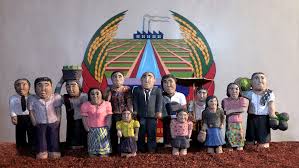Each year, the Academy of Motion Picture Arts and Sciences releases a shortlist of foreign language films that are eligible for an Academy Award. For more on how the process works, click here. In anticipation of that event, we will look at 2013’s nine shortlisted films. Go here for the first two installments. This week is Cambodia’s official selection, The Missing Picture.
Cambodian writer and director Rithy Panh lost his home, family and even his identity when he was a teenager. The Missing Picture is Panh’s cinematic quest to reclaim his past and bear witness to the brutal genocide that tore his homeland apart.
The Missing Picture begins in 1975 when Panh was a happy 13 year old living a quiet middle-class life with his parents and siblings in Cambodia’s capital, Phnom Penh. Panh recalls happy days spent going to school, attending backyard dinner parties and listening to his brother’s rock’n’roll band.
Panh’s world was shattered when Khmer Rouge revolutionaries deposed the Cambodian government. Khmer Rouge believed in an extreme form of Marxism and nationalism that would lead to a so-called “peasant” society where all Cambodians would live a completely agricultural life and all foreign influences, including movies, music and books, would be banned.
To achieve their goals, Khmer Rouge embarked on a ruthless campaign of torture and execution. They killed anyone considered an artist or intellectual, including Panh’s musician brother, and they let many other Cambodians die of treatable diseases or starve to death. Roughly 2 million people, about 70 percent of Cambodia’s population, died during Khmer Rouge’s four-year reign.
Panh’s parents, all of his siblings and most of his extended family perished in the killing fields. Panh was stripped of all personal possessions, except for a basic black uniform and a spoon. He was given a new identity and sent to work at a labor camp where he was constantly indoctrinated with Khmer Rouge ideology. Panh survived through sheer willpower and escaped to Thailand in 1979.
The Missing Picture is a powerful film, not only because of the subject matter, but because of the manner in which Panh tells his story. Khmer Rouge leaders were careful to cover up their atrocities, so there is very little film footage or photographs of the genocide. Instead, Panh uses clay figurines in meticulously detailed dioramas to recreate his memories (these were made by the artist Sarith Mang). This seems like a terrible idea (I’ll admit I was skeptical going in), but it works beautifully.
The figurines become real characters through the skill of the artists involved. A particularly moving scene is a montage of family portraits through the years. The first portrait (pictured above) shows a large happy family, all smiling in their colorful clothes. The next portrait shows the family after the revolution, somber and attired in black uniforms. One by one most of the family disappears until , in the last portrait, there are only a few gaunt bodies covered in rags.
The Missing Picture was Cambodia’s first-ever entry in the foreign language category. It was one of the five films on the official Oscar ballot and the film richly deserved that honor. Certainly, Oscar voters have honored films about the Cambodian genocide before (The Killing Fields won three Academy Awards in 1984), but The Missing Picture is unique because it was made by a Cambodian and does not feature any Western characters.
The Missing Picture is available on Netflix Instant and DVD.
Next week we’ll look at The Hunt from Denmark.


